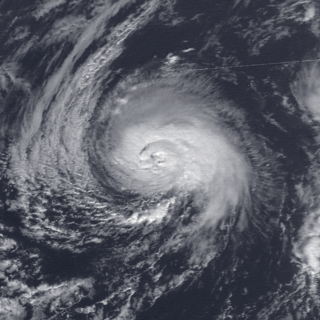The name Frances has been used for eight tropical cyclones in the Atlantic Ocean and for one in the Australian region.
The name Bertha has been used for eight tropical cyclones in the Atlantic Ocean.
The name Gustav was used for five tropical cyclones in the Atlantic Ocean:
The name Alberto has been used for seven tropical cyclones in the Atlantic Ocean:
The name Jose has been used for six tropical cyclones worldwide, five in the Atlantic Ocean and one in the Western Pacific Ocean, a typhoon that traversed the Philippine Atmospheric, Geophysical and Astronomical Services Administration (PAGASA) area of responsibility. The name was retired by PAGASA from future use in the region after that one use, and replaced with Josie for the 2018 Pacific typhoon season.
The name Gilma has been used for eight tropical cyclones in the Eastern Pacific Ocean.
The name Hector has been used for eight tropical cyclones in the Eastern Pacific Ocean:
The name Irene was used for eight tropical cyclones worldwide, eight in the Atlantic Ocean one in the Western Pacific Ocean, as well as for one extratropical European windstorm.

Hurricane Lili was the third of only four Atlantic tropical cyclones on record to reach hurricane status in the month of December with the others being an unnamed hurricane in 1887, December 1954's Alice, and 2005's Epsilon. The final of thirteen tropical storms in the 1984 Atlantic hurricane season, Lili developed as a subtropical cyclone which originated from a frontal trough to the south of Bermuda on December 12. It tracked southeastward, then northward, slowly attaining tropical characteristics and becoming a hurricane on December 20. Lili turned to the south and southwest, briefly threatening the northern Caribbean islands before weakening and dissipating near the coast of the Dominican Republic. The storm produced light rainfall but no damage.

Hurricane Epsilon was the 27th named tropical or subtropical storm and the final of 15 hurricanes in the record-breaking 2005 Atlantic hurricane season. Originating from a cold front beneath an upper-level low, Epsilon formed on November 29 about 915 mi (1470 km) east of Bermuda, becoming the second tropical storm to do so in that area of the Atlantic within the span of a week. Initially, the National Hurricane Center (NHC) forecast the storm to transition into an extratropical cyclone within five days, due to conditions unfavorable for significant intensification. Epsilon continually defied forecasts, at first due to an unexpected loop to the southwest, and later due to retaining its strength despite cold waters and strong wind shear.
The name Zeta has been used for two tropical cyclones in the Atlantic Ocean.

Hurricane Epsilon was a strong tropical cyclone that affected Bermuda, and parts of North America and Western Europe. The twenty-seventh tropical or subtropical cyclone, the twenty-sixth named storm, the tenth hurricane, and the fourth major hurricane of the extremely-active 2020 Atlantic hurricane season, Epsilon had a non-tropical origin, developing from an upper-level low off the East Coast of the United States on October 13. The low gradually organized, becoming Tropical Depression Twenty-Seven on October 19, and six hours later, Tropical Storm Epsilon. The storm executed a counterclockwise loop before turning westward, while strengthening. On October 20, Epsilon began undergoing rapid intensification, becoming a Category 1 hurricane on the next day, before peaking as a Category 3 major hurricane on October 22, with maximum 1-minute sustained winds of 115 mph (185 km/h) and a minimum central pressure of 952 millibars (28.1 inHg). This made Epsilon the easternmost major hurricane this late in the calendar year, as well as the strongest late-season major hurricane in the northeastern Atlantic, and the fastest recorded case of a tropical cyclone undergoing rapid intensification that far northeast that late in the hurricane season. Afterward, Epsilon began to weaken as the system turned northward, with the storm dropping to Category 1 intensity late that day. Epsilon maintained its intensity as it moved northward, passing to the east of Bermuda. On October 24, Epsilon turned northeastward and gradually accelerated, before weakening into a tropical storm on the next day. On October 26, Epsilon transitioned into an extratropical cyclone, before being absorbed by another larger extratropical storm later that same day.
This page is based on this
Wikipedia article Text is available under the
CC BY-SA 4.0 license; additional terms may apply.
Images, videos and audio are available under their respective licenses.


